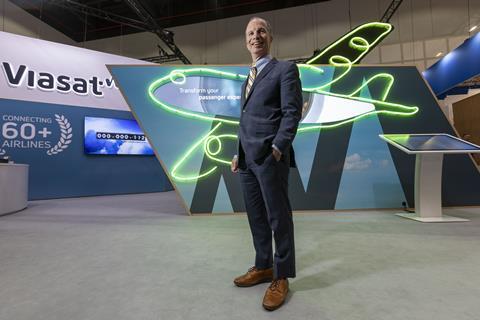In-flight connectivity specialist Viasat was at AIX a year on from its merger with Inmarsat and determined to keep satellite supply ahead of ever-growing passenger demand for wi-fi services.
Viasat concluded its merger with Inmarsat in June last year and vice-president and general manager for commercial aviation Don Buchman says that the combination brings together the breadth of Inmarsat’s global service with Viasat’s more focused service.

”They had a lot of coverage, but not a lot of density in any one spot. Viasat took the opposite [approach] and started on the regional in the United States, Europe, Australia and Brazil. We were serving high-density domestic routes,” he explains.
”Now we are taking that mission globally and that has taken the Viasat promise that we’ve done in the United States and regionally, and Inmarsat’s mission which is bringing wi-fi globally, bringing those together and a year on now we are busy in a full integration of our businesses and airlines around the world are able to enjoy our roadmap.
”We keep delivering innovations, and these are bringing more and more capacity into orbit.”
Capacity has always been key to the Viasat approach Buchman explains.
”We looked at it as a supply and demand problem,” he says. “We really went after making sure we had enough supply. We know the demand is going to be there and we know the demand is going to be increasing every year. Every year there is another new application coming up. That’s been pretty much our singular focus and we’ve been delivering that.”
Buchman says Viasat, whose recent in-flight connectivity deals include a follow-on order covering 40 Boeing 787s from Korean Air and a commitment to equip more than 40 aircraft from Royal Jordanian, has seen a shift in thinking from airlines regarding the value of high-quality connectivity since the pandemic.
”Five or 10 years ago it was probably ’I just have to have wi-fi it doesn’t matter if it was high-quality or not’,” he says. ”But the reality was the quality of wi-fi reflected the quality of the airline.
”We spent a lot of time saying that was important but I’d say the pivot point was coming out of Covid. When the public started flying again out of Covid, I’ll say that was the one big thing we saw was that everyone wanted to be online and airlines that really embraced it, took that in and when they saw take-up rates, it [the wi-fi] really had to work.
”So that quality was expected when they started flying again post-Covid, and now I’m not trying to convince airlines they need good wi-fi, now it’s convincing them how best can we get it on,” he says.


























